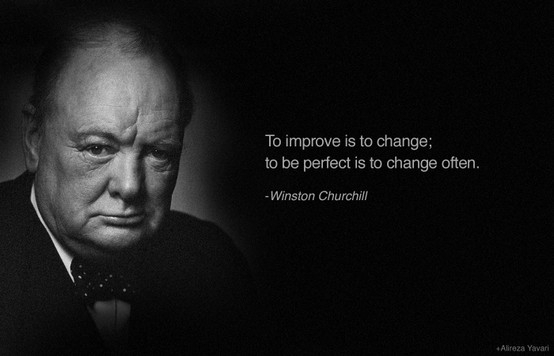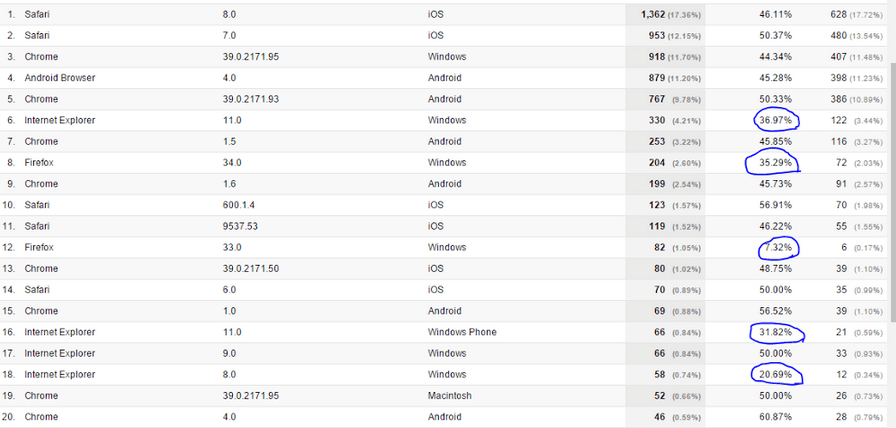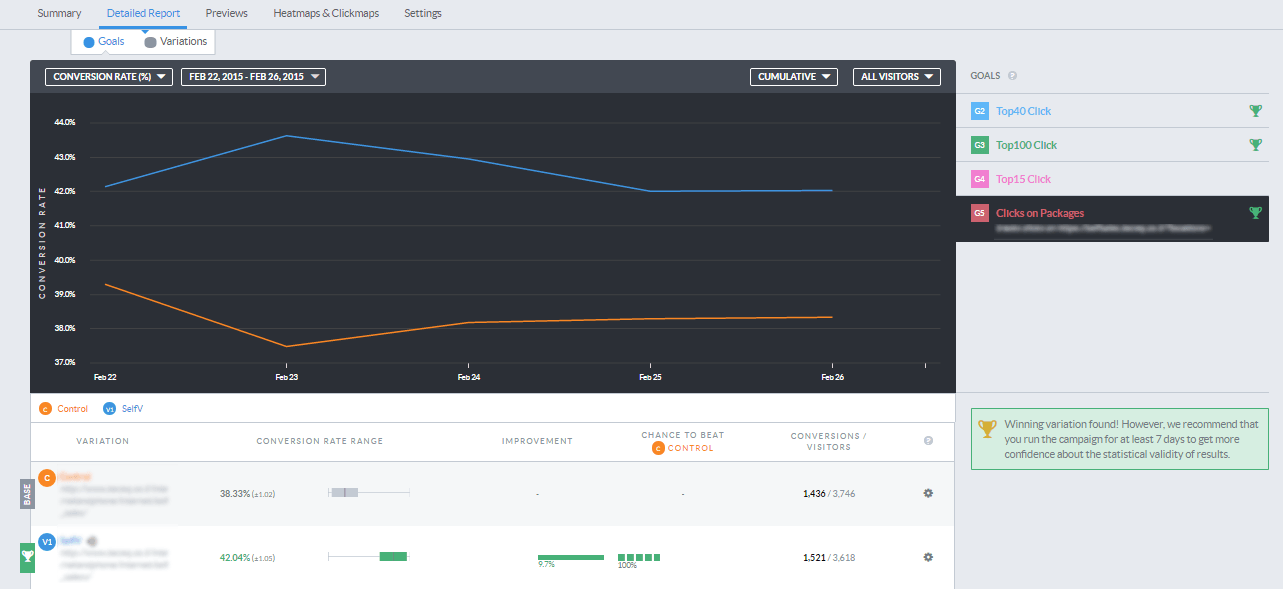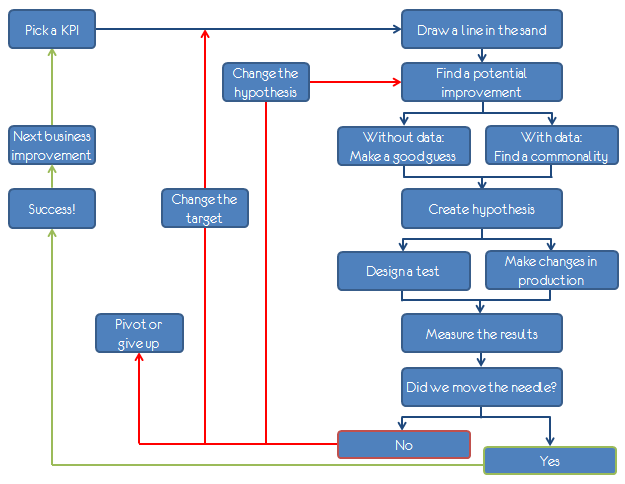A Conversion Optimization Guide for Beginners
Use our conversion optimization guide for beginners to improve and improve and improve your website’s performance and push your limits even further.

“To improve is to change; to be perfect is to change often.” said the great Winston Churchill. But simply changing is not enough. When optimizing websites you need to know you’re changing in the right direction. You want to be using a data-driven growth strategy instead of just guessing. The following article is meant to provide you with an actionable conversion optimization guide, including the absolute must-dos in any conversion rate optimization process, to help you in achieving your initial CRO goals yourself.
A Full On Paradigm Shift
The user experience you provide your users acts as your website’s business model. You wouldn’t start a business or make changes to your business model based on intuition alone, and it’s time you take this approach and apply it to your online assets. This is conversion rate optimization, a long term, ongoing strategic process of optimizing every aspect of your website, not just to better suite your users’ needs, but with the specific aim of improving your business’ performance.
This process is one that requires investing both time and money. If you’re hesitant, you can start small and expand once you start seeing results. If you’re just starting out, and you follow our lead, you’ll see how beneficial this practice can be. While there are “no silver bullets,” our years of collective experience at Conversioner have lead us to come up with these simple steps, to get your DIY CRO project not only up and running, but showing results.
Web analytics guru Avinash Kaushik writes about the lean analytics cycle: Metrics>Hypothesis>Experiment>Act as seen in the figure below. We’ll break it down for you and incorporate actionable and informative tips and resources.
Track, Set Goals & Start your Analysis
Before you can even think about running a/b tests, you need to make sure that you know what you’re looking at. This means, properly setting up your Google Analytics account, defining your goals and searching for potential leaks in your funnel. To some, finding the problem can be every bit as challenging as finding the right solution.
If you think that this is just a preliminary step that you can skip with no harm done, think again. Any resource you put into better understanding your Analytics in early stages will come back to you ten fold in later steps.
After you’ve chosen your Key Performance Indicators and defined your Google Analytics goals, it’s time to start putting them to good use and find some leaks. Depending on how much traffic your website gets you’ll need to give it some time to accumulate data from your new goals. Once a few days have gone by, checkout these four critical reports, your top sources for leaks:
-
Landing pages/Exit pages – This report let’s you see how your different pages perform. find the ones that are underperforming and start asking yourself, WHY? (we’ll get to that later)
-
Devices – In addition to looking at per page performance, you need to also look for cross website performance for different audiences. Don’t be surprised to see that your mobile conversion rates are lower than the desktop’s, but see if there are any specific devices underperforming. If you find that on iPhone 5 your conversion rates are way lower, be sure to check for specific functionality or design bugs that are hurting your conversion rates.
-
Browsers – Here you can see how your website is performing on different browsers and browser versions. For more checkout Douglas’s #1 insight on his post on how sports tactics can increase conversion rate.
-
Traffic Sources – Different audiences react differently to your content. Use this report to see how users from Facebook convert differently from users from organic or paid search. In later steps you can optimize your content according to this report and fit it to your users’ needs.

Dig Deeper
Now that you have a basic understanding of how users interact with you website, it’s time you find the right place to start your optimization before coming up with a plan for the changes that you think can improve your conversion rates.
For the first part, we recommend starting with a page that is as high up in your funnel as possible – a landing page – where you can make an impact on your entire funnel. Whether it’s your homepage or a dedicated landing page for a specific traffic source, you need to make sure that this page gets sufficient traffic. Running a/b tests with less than a hundred sessions a day can be both excruciating and ineffective. Check out Talia’s elaborate posts on Getting started with landing page optimization and The 5 key elements for landing page optimization.
Before you jump to conclusion about your pages, and this is crucial to the whole process, it’s important that you base your decisions on data and not on intuition. To do that you’ll need to go a little deeper in your analysis, utilizing the capabilities of User behavior analysis tools. This will allow you to come up with hypotheses or at the very least back up your intuition with data before taking tests live.
Hypothesize
This is the fun part. Based on the two previous steps you can now come up with the brilliant ideas that will literally make you more money. Most optimizers just play around with elements on their page, changing the color of the call to action button or the copy of the title, and that’s ok. But if you really want to see your conversion rates climb, you need to start using emotional triggers, testing holistic and strategic hypothesis and not just elements. Tapping into the psychological process your users undergo are your real key to success. 
For additional inspiration checkout our recent landing page critiques that incorporate suggestions for tests that are varied in type and scope:
Pick a tool, setup and start testing your hypothesis
Think you know what you need to do to increase your conversion rate? Great! It’s testing time. Pick an a/b testing tool that has a “What You See Is What You Get” editor that will allow you to create a variation of you original page, changing just the elements you want to test. These tools have come a long way over the years and are very intuitive, pretty easy to use and offer great support and whole communities of users.
Make sure that you measure the effect of your changes across your entire funnel. Don’t settle for measuring CTR; remember the goal here, you want to see the effect on your revenue. After a day or two you can usually tell if you have something wrong in the setup but only after a minimum of two weeks you can start relying on the trend that you’re seeing, and only once you’ve reached statistical significance can you announce a winning variation.
*When you setup your first test, remember: forms and checkout processes have backend implications that require your tech team’s attention, so unless you’re doing this as part of an official project with allocated resources, we recommend sticking to landing pages.

Repeat and Expand
Running a successful a/b test does not mean having a successful conversion optimization process. For that you need to really commit yourself to learning, analyzing and optimizing your website by running test cycles on different part of you funnel. Furthermore, for us at Conversioner the steps listed above are a first measure, aimed at generating knowledge and insights before diving into a much deeper analysis of site-specific audiences and emotional triggers. We don’t believe in just testing elements on pages; we test strategies and in return we see much greater increases in conversion rates.



Pingback: The Click Chicks - The 6 women you must follow if you want your website to convert better - Conversion Green()
Pingback: Mobilegeddon - How Publishers Can Survive Google's Update()
Pingback: 4 Meaningful Landing Page AB Test Ideas to Run Today()